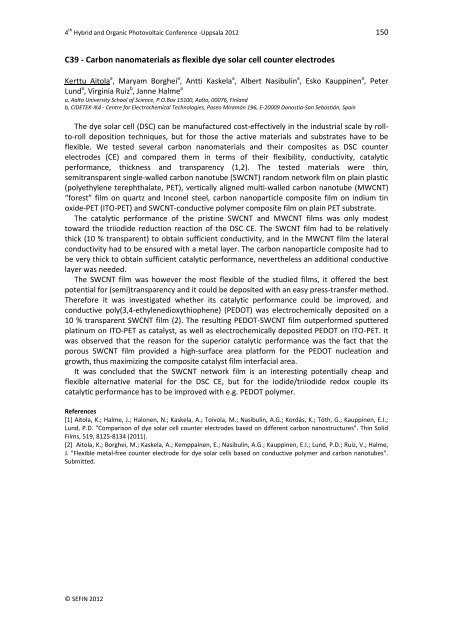HOPV12 - Blogs
HOPV12 - Blogs
HOPV12 - Blogs
Create successful ePaper yourself
Turn your PDF publications into a flip-book with our unique Google optimized e-Paper software.
4 th Hybrid and Organic Photovoltaic Conference -Uppsala 2012 150<br />
C39 - Carbon nanomaterials as flexible dye solar cell counter electrodes<br />
Kerttu Aitola a , Maryam Borghei a , Antti Kaskela a , Albert Nasibulin a , Esko Kauppinen a , Peter<br />
Lund a , Virginia Ruiz b , Janne Halme a<br />
a, Aalto University School of Science, P.O.Box 15100, Aalto, 00076, Finland<br />
b, CIDETEK-IK4 - Centre for Electrochemical Technologies, Paseo Miramón 196, E-20009 Donostia-San Sebastián, Spain<br />
The dye solar cell (DSC) can be manufactured cost-effectively in the industrial scale by rollto-roll<br />
deposition techniques, but for those the active materials and substrates have to be<br />
flexible. We tested several carbon nanomaterials and their composites as DSC counter<br />
electrodes (CE) and compared them in terms of their flexibility, conductivity, catalytic<br />
performance, thickness and transparency (1,2). The tested materials were thin,<br />
semitransparent single-walled carbon nanotube (SWCNT) random network film on plain plastic<br />
(polyethylene terephthalate, PET), vertically aligned multi-walled carbon nanotube (MWCNT)<br />
“forest” film on quartz and Inconel steel, carbon nanoparticle composite film on indium tin<br />
oxide-PET (ITO-PET) and SWCNT-conductive polymer composite film on plain PET substrate.<br />
The catalytic performance of the pristine SWCNT and MWCNT films was only modest<br />
toward the triiodide reduction reaction of the DSC CE. The SWCNT film had to be relatively<br />
thick (10 % transparent) to obtain sufficient conductivity, and in the MWCNT film the lateral<br />
conductivity had to be ensured with a metal layer. The carbon nanoparticle composite had to<br />
be very thick to obtain sufficient catalytic performance, nevertheless an additional conductive<br />
layer was needed.<br />
The SWCNT film was however the most flexible of the studied films, it offered the best<br />
potential for (semi)transparency and it could be deposited with an easy press-transfer method.<br />
Therefore it was investigated whether its catalytic performance could be improved, and<br />
conductive poly(3,4-ethylenedioxythiophene) (PEDOT) was electrochemically deposited on a<br />
10 % transparent SWCNT film (2). The resulting PEDOT-SWCNT film outperformed sputtered<br />
platinum on ITO-PET as catalyst, as well as electrochemically deposited PEDOT on ITO-PET. It<br />
was observed that the reason for the superior catalytic performance was the fact that the<br />
porous SWCNT film provided a high-surface area platform for the PEDOT nucleation and<br />
growth, thus maximizing the composite catalyst film interfacial area.<br />
It was concluded that the SWCNT network film is an interesting potentially cheap and<br />
flexible alternative material for the DSC CE, but for the iodide/triiodide redox couple its<br />
catalytic performance has to be improved with e.g. PEDOT polymer.<br />
References<br />
[1] Aitola, K.; Halme, J.; Halonen, N.; Kaskela, A.; Toivola, M.; Nasibulin, A.G.; Kordás, K.; Tóth, G.; Kauppinen, E.I.;<br />
Lund, P.D. "Comparison of dye solar cell counter electrodes based on different carbon nanostructures". Thin Solid<br />
Films, 519, 8125-8134 (2011).<br />
[2] Aitola, K.; Borghei, M.; Kaskela, A.; Kemppainen, E.; Nasibulin, A.G.; Kauppinen, E.I.; Lund, P.D.; Ruiz, V.; Halme,<br />
J. "Flexible metal-free counter electrode for dye solar cells based on conductive polymer and carbon nanotubes".<br />
Submitted.<br />
© SEFIN 2012


